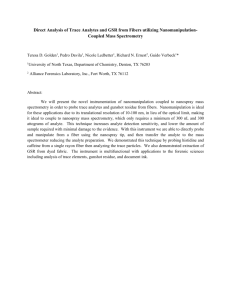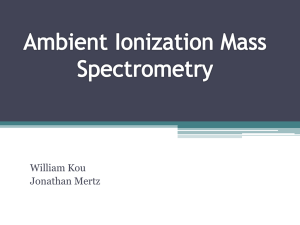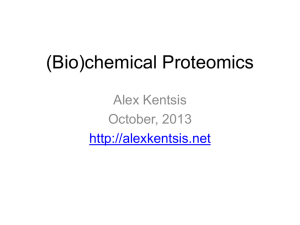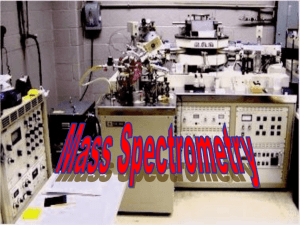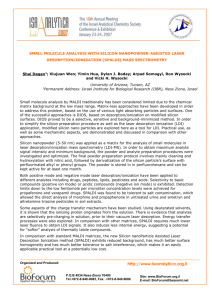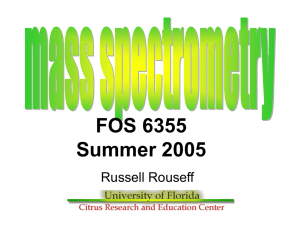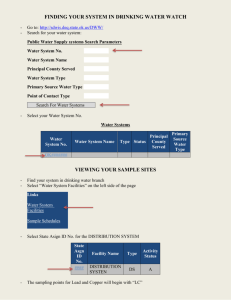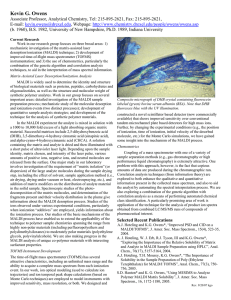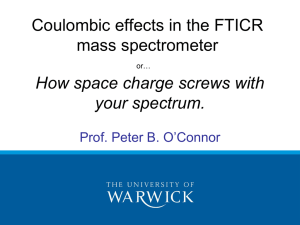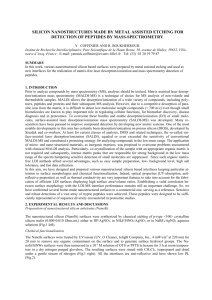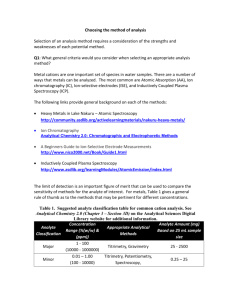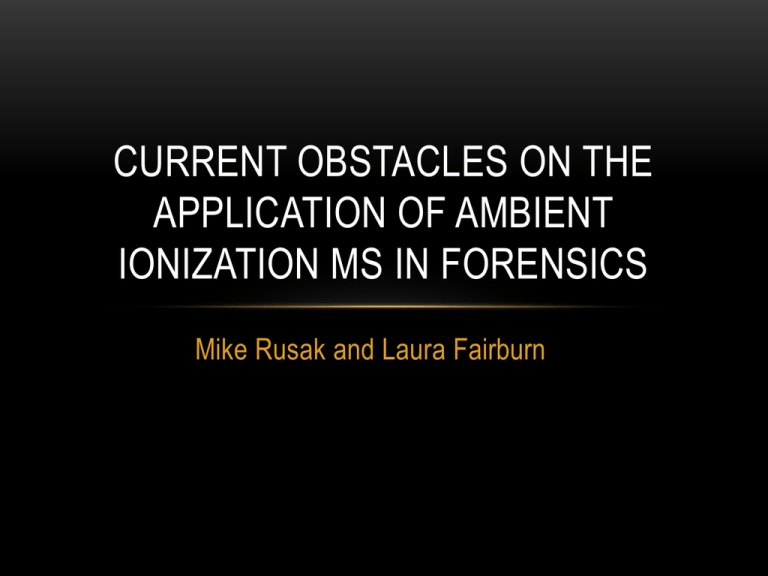
CURRENT OBSTACLES ON THE
APPLICATION OF AMBIENT
IONIZATION MS IN FORENSICS
Mike Rusak and Laura Fairburn
SUMMARY OF THE DRAWBACKS
• Cost
• Professional experience is needed
• Lack of comparable data
• Ionization is affected by spray, chemical, and surface
parameters.
• Problems with portability
SUMMARY OF THE DRAWBACKS
• Utilization of standards
• Problems with quantitative analysis
• Lack of research on matrix effects
• Lack of field testing
• Information obtained is not yet applicable to current
standards
COST
• Cost of the operator and the equipment can’t be
afforded by police departments
• The knowledge for just the calibration and
operation is very specialized, increasing one’s
expected salary
• Not a very practical purchase for a small police
department
• Right now, the prototypes of the portable MS
machines can only be afforded by the US military
EXPERIENCE NEEDED
• Need to have a lot of experience and education
• You can’t just walk off the street, be given
basic training and then be allowed to
operate the equipment and deemed an
expert
• Most evidence requiring MS is outsourced to
specialized forensic labs
LACK OF COMPARABLE DATA WHEN
WORKING WITH UNKNOWNS
• Since this technique is still in the prototype
phase, there aren’t many successful standard
cases to compare one’s results as few labs use
this technique
• All results need to be confirmed with other
techniques such as IR and NMR, or GC-MS
PARAMETERS THAT AFFECT IONIZATION
• All of the following parameters can be very difficult to
control in the field
1.Geometric parameters
2.Spray parameters
3.Chemical parameters
4.Surface parameters
PORTABILITY
• The large volume and power supply needed
reduces the portability of the machine
• Currently, portable machines are very rare and
experimental
• Compromises sensitivity and accuracy of
readings
UTILIZATION OF STANDARDS
• Standards are used to quantify and identify the analyte of
interest
• There’s a dependence of the ion signal on the type of
substrate present
• Eg) Thermal conductivity of substrate/matrix can
influence the signal
• Roughness of substrate
• Hard to quantify an analyte use a conventional MS
apparatus instead
UTILIZATION OF STANDARDS
• If it isn’t possible to mix in a standard, an intrinsic
compound of known concentration can be used, which
isn’t ideal.
• Not very quantitative
MATRIX EFFECTS
• Matrix: the material the analyte of interest is mixed with
• Influences desorption and ionization of the analyte
• Eg) cream, fillers (in the case of medicinal tablets),
dirt, carpet, etc.
• Systematic matrix studies are rare
MATRIX EFFECTS
• The matrix can cause overlap in the spectra due to
unwanted compounds
• Can also cause ion suppression
• Less volatile compounds in the matrix disrupt droplet
formation or evaporation, suppressing the amount of
ions reaching the detector
• Can react with analyte during desorption or ion
formation
MATRIX STUDIES
• Yu et al. studied the effect of different biological
matrices on the observed signal via DART analysis
• Showed that verapimil analyte signal can be reduced to
50% in bile, and 3% in brain tissue homogenate,
compared to verapimil in neat solvent
• Also showed that matrix effects are compound
dependent.
MATRIX STUDIES
• Jecklin et al. showed how the limit of detection (LOD)
varies when analyzing pesticides in different fruit juice
matrices
• The authors noted that background intensities were not
responsible for the observed changes
LACK OF FIELD TESTING
• Explosives, toxic industrial compounds, chemical
warfare agents, etc., have been explored by a variety of
methods
• Analysis of these compounds is limited for that fact that
the experiments are very controlled.
• Either done from standard solutions or complex
matrices doped with standards
LACK OF FIELD TESTING
• For drug analysis, pure chemicals are usually spiked
onto food, skin, or other surfaces.
• More research needs to be done with real evidence and
analytes in a non-standardized environment.
APPLICABILITY
• Yield a type of information which may not be applicable
to current standards
• Eg) Food policy requires that pesticide levels be
measured in concentration (wt/wt), which requires
homogenizing the fruit/veggies of concern.
• Sample preparation still needs to be done in some
cases
• Eg) To reduce ion suppression, especially for
analytes in a low concentration in complex matrices
REFERENCES
•
Alberici, Rosana M. et al. Ambient mass spectrometry: bringing MS into the “real world”.
Anal Bioanal Chem. 2010, 398: 265–294
•
Cooks et al., Forensic Applications of Ambient Mass Spectrometry. Anal Bioanal Chem
(2009) 394, 1995-2008
•
Chen et al., What Can We Learn From Ambient Ionization Techniques? J Am Soc Mass
Spectrom (2009) 20, 1947-1963
•
Gamez et al., Atmospheric pressure glow discharge desorption mass spectrometry for
rapid screening of pesticides in food. Rapid Commun Mass Spectrom. (2008) 22, 27912798
•
Takats, Zoltan et al. Ambient mass spectrometry using desorption electrospray ionization
(DESI): instrumentation, mechanisms and applications in forensics, chemistry, and
biology. J. Mass Spectrom. 2005, 40: 1261–1275
•
Yu et al., Bioanalysis without Sample Cleanup or Chromatography: The Evaluation and
Initial Implementation of Direct Analysis in Real Time Ionization Mass Spectrometry for
the Quantification of Drugs in Biological Matrixes. Anal Chem. (2009) 81,193-202

